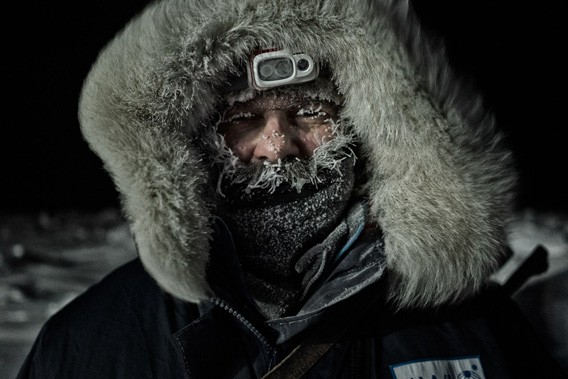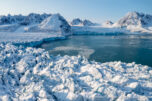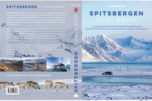-
current
recommendations- Liefdefjord
New page dedicated to one of Spitsbergen's most beautiful fjords. Background information and many photos.
- New Spitsbergen guidebook
The new edition of my Spitsbergen guidebook is out and available now!
- Liefdefjord
New page dedicated to one of Spitsbergen's most beautiful fjords. Background information and many photos.
Page Structure
-
Spitsbergen-News
- Select Month
- May 2025
- April 2025
- March 2025
- February 2025
- January 2025
- December 2024
- November 2024
- October 2024
- September 2024
- August 2024
- July 2024
- June 2024
- May 2024
- April 2024
- March 2024
- February 2024
- January 2024
- December 2023
- November 2023
- October 2023
- September 2023
- August 2023
- July 2023
- June 2023
- May 2023
- April 2023
- March 2023
- February 2023
- January 2023
- December 2022
- November 2022
- October 2022
- September 2022
- August 2022
- July 2022
- June 2022
- May 2022
- April 2022
- March 2022
- February 2022
- January 2022
- December 2021
- November 2021
- October 2021
- September 2021
- August 2021
- July 2021
- June 2021
- May 2021
- April 2021
- March 2021
- February 2021
- January 2021
- December 2020
- November 2020
- October 2020
- September 2020
- August 2020
- July 2020
- June 2020
- May 2020
- April 2020
- March 2020
- February 2020
- January 2020
- December 2019
- November 2019
- October 2019
- September 2019
- August 2019
- July 2019
- June 2019
- May 2019
- April 2019
- March 2019
- February 2019
- January 2019
- December 2018
- November 2018
- October 2018
- September 2018
- August 2018
- July 2018
- June 2018
- May 2018
- April 2018
- March 2018
- February 2018
- January 2018
- December 2017
- November 2017
- October 2017
- September 2017
- August 2017
- July 2017
- June 2017
- May 2017
- April 2017
- March 2017
- February 2017
- January 2017
- December 2016
- November 2016
- October 2016
- September 2016
- August 2016
- July 2016
- June 2016
- May 2016
- April 2016
- March 2016
- February 2016
- January 2016
- December 2015
- November 2015
- October 2015
- September 2015
- August 2015
- July 2015
- June 2015
- May 2015
- April 2015
- March 2015
- February 2015
- January 2015
- December 2014
- November 2014
- October 2014
- September 2014
- August 2014
- July 2014
- June 2014
- May 2014
- April 2014
- March 2014
- February 2014
- January 2014
- December 2013
- November 2013
- October 2013
- September 2013
- August 2013
- July 2013
- June 2013
- May 2013
- April 2013
- March 2013
- February 2013
- January 2013
- December 2012
- November 2012
- October 2012
- September 2012
- August 2012
- July 2012
- June 2012
- May 2012
- April 2012
- March 2012
- February 2012
- January 2012
- December 2011
- November 2011
- October 2011
- September 2011
- August 2011
- May 2011
- April 2011
- March 2011
- February 2011
- January 2011
- December 2010
- November 2010
- September 2010
- August 2010
- July 2010
- June 2010
- May 2010
- April 2010
- March 2010
- February 2010
- November 2009
- October 2009
- August 2009
- July 2009
- June 2009
- May 2009
- April 2009
- March 2009
- February 2009
- January 2009
- December 2008
- November 2008
- October 2008
- August 2008
- July 2008
- June 2008
- May 2008
- April 2008
- March 2008
- February 2008
- April 2000
- Select Month
-
weather information
-
Newsletter

| Guidebook: Spitsbergen-Svalbard |
Home →
Yearly Archives: 2021 − News
Arctic online presentations “Arctic Wednesday”: final night with Thomas Ulrich
It started with a couple of presentations in November and December, and in January, Birgit Lutz and I joined forces and created the online presentation series “The Arctic Wednesday”. Next Wednesday, 28 April, the current series will come to an end, when the Swiss polar adventurer Thomas Ulrich takes up to the highest latitudes. “Arctic Solo” is the dramatic story of a North Pole Expedition that brought Thomas into dangerous and desperate situations – ant it is the story of Thomas finding a way out and to continue stronger than ever.
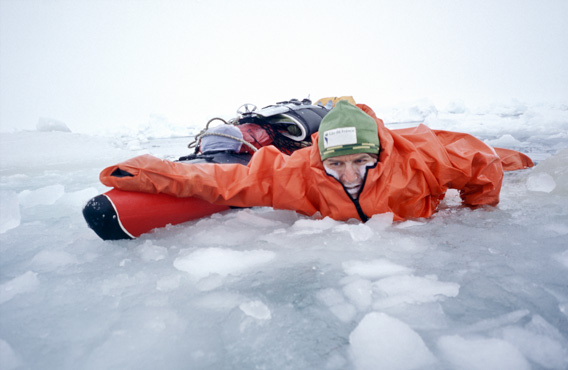
Thomas Ulrich: “Arctic Solo”. A dramatic adventure as the final highlight of the arctic online presentation series “The Arctic Wednesday”.
Where Birgit and I, with contributions by Udo Zoephel (the MOSAiC-expedition), Sandra Walser (Hans Beat Wieland/Wilhelm Bade) and Henry Páll Wulff (Iceland), focussed on knowledge of different arctic areas and various chapters of the regional history, Thomas will take us out into the wild! A final highlight that were a really excited about, and we hope that many of you will join us!
The presentation will be in German. Click here for tickets.
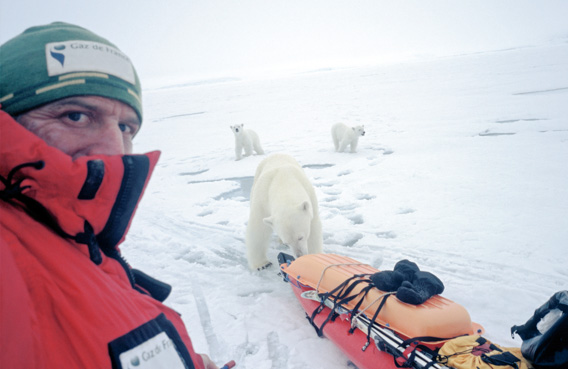
In the presentation “Arctic Solo”, we will encounter a lot of ice, icy temperatures and definitely a polar bear every now and then.
The project “The Arctic Wednesday” has developed with amazing force and it has kept us busy for several months. It has carried us through a period that is not the easiest of all times for the travel industry, especially for self-employed/freelance guides/expedition leaders/authors/photographers who often can not count on public support during the corona crisis. So the “Arctic Wednesday” has been a project of vital importance for us – a big, warm, heart-felt “thank you” to everybody who has joined us on Wednesday evenings since early January! We will continue, that’s pretty sure. But after next Wednesday’s presentation, it is time for a break. Both Birgit and I have got other projects that do require our attention, and let’s hop that the arctic summer will give us the chance to travel again. Fingers crossed!
Thomas Ulrich: Arctic Solo (presentation)
Some impression of Thomas Ulrich’s arctic adventures. Join us on Wednesday for more!
- gallery anchor link: #gallery_1920
Click on thumbnail to open an enlarged version of the specific photo.
Cod war between Norway and EU about to escalate
A new “cod war”, a conflict about fishing rights, has been lurking in the Barents Sea already for some time. The problem is a disagreement about cod quotas for European fishing ships in the 200 mile zone around Svalbard. The matter is complex.
The problem: EU fishing quotas after the Brexit
On the surface, the problem appears to be new quotas for European fishing vessels that Norway has set after the Brexit by deducting the British quota from the European allowance. The new European quota amounts to 17,885 tons, according to NRK, while British fishing vessels are afforded a quota of 5,000 tons. The EU, however, is not happy about this new quota and reacted by allocating themselves a quota of 28,431 tons, something that is not accepted by Norway. The EU accused the current Norwegian fishery policy of being arbitrary and discriminatory.
Both sides have now verbally rigged up, both saying they are prepared to take steps as necessary to take care of their rights. Norway has made clear that coastguard and police are ready to take the usual steps in case they find fishing vessels with illegal catch in their waters, including confiscation of ships and catches and arrestation of crews. It was Lars Fause, chief prosecutor in north Norway, who said this. Later this year, Fause will follow Sysselmann Kjerstin Askholt in Longyearbyen as the first one to bear the gender-neutral title Sysselmester.
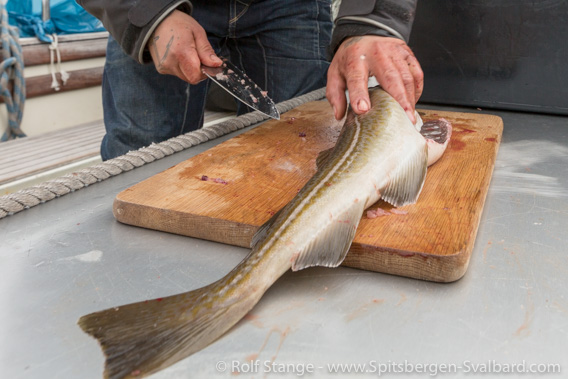
Yummy cod taken in Isfjord.
The conflict between the EU and Norway is, however, about other volumes.
Key problem: the Spitsbergen Treaty
But the essential problem is hidden in the paragraphs of the Spitsbergen Treaty. The second article of the treaty guarantees that “Ships and nationals of all the High Contracting Parties shall enjoy equally the rights of fishing and hunting in the territories specified in Article 1 and in their territorial waters.” The problem is the definition of “territorial waters”. The Spitsbergen Treaty was signed in 1920. Until then, most countries looked upon coastal waters within 3 miles (a gun shot) as their territorial waters. It was not before 1921 that governments began to include the waters as far out as 12 miles into their own territory. Until today, this is not everywhere as clearly defined as one might think or wish, but as far as this, there is consensus in the area in question: everybody agrees that the Spitsbergen Treaty is valid within the 12 mile zone (territorial waters) around Svalbard, meaning that fishing ships of all treaty parties enjoy equal rights there.
The problem starts when it comes to the exclusive economic zone (EEZ), which stretches as far as 200 miles from the coast. Hence, the EEZ is much larger and includes large and valuable biological resources. The EEZ was, however, not defined in internatinal law before 1982, when the United Nations Convention on the Law of the Sea was concluded.
Based on article 1 of the Spitsbergen Treaty, Norway claims “full and absolute sovereignty” also of the large exclusive economic zone (200 mile zone), but insists at the same time that article 2 ot the same treaty, which gives all treaty parties equal rights, is not valid there. In contrast, Norway claims exclusive rights in the EEZ. It does not really surprise that there are those treaty parties who do not agree with this position.
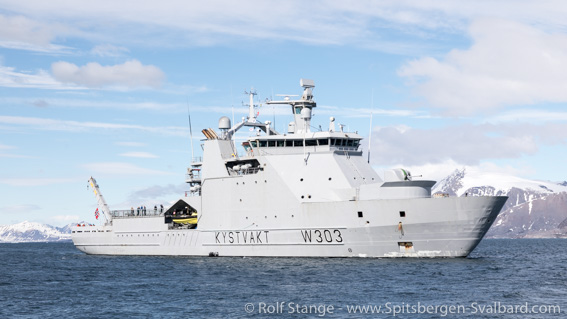
The coastguard guarantees Norwegian sovereignty in the waters around Spitsbergen. Unfriendly encounters of coastguard vessels and EU fishing vessels may be coming up.
The Spitsbergen Treaty and the “exclusive economic zone (EEZ)”
Whatever one’s position is on the question wether or not the Spitsbergen Treaty and its fundamental principle of equal rights and access (non-discrimination) is to be applied in the EEZ, there can hardly be any doubts that fishing vessels from the EU or third countries need to respect Norwegian economical rights in these waters. The question is, however, how Norway may balance the quotas that are allocated to foreign fishing vessels relative to their national quotas: according to the principle of non-discrimination (if article 2 of the Spitsbergen Treaty is to be applied) or exclusively.
A complex matter. What is clearly missing is an authority accapted by all sides that could decide on such matters of interpretation regarding the Spitsbergen Treaty. Norway insists to possess the exclusive authority to such questions, but that is not accepted by Brussels.
While there is political and juridical need for clarification, both the Norwegian coastguard and European fishing vessels are getting prepared and conflicts are to be feared. The staggered observer keeps watching and wondering.
Victims of domestic violence in Svalbard potentially in defenceless position
Krisesenteret Tromsø, an institution to help victims of domestic violence, has raised an alarming debate. According to an article published in NRK, victims of domestic violence may be in a far more helpless situation in Longyearbyen than in mainland Norway.
Background: the Spitsbergen Treaty
The background is related to the Spitsbergen Treaty, according to which citizens of all signatory countries have free access to Svalbard. As a result, everybody can live and work there without visa and work permit restrictions (a Schengen visa can be necessary to get to Spitsbergen because access is only available through the Schengen treaty area).
Hence, the Norwegian “utlendingsloven” (foreigner law) is not valid in Svalbard, which regulates access and residents of foreigners in Norway. But this law also provides support to non-Norwegian victims of domestic violence in Norway, for example access to dedicated institutions such as Krisesenteret Tromsø (or elsewhere) and to lawyers, to name some examples. This is not available in Longyearbyen, because the law is not valid in Svalbard. This can put foreign women, who are financially dependent on their partner, in a very difficult position: if they are not able to support themselves financially, then returning to their country of origin is likely to be the only solution available. But these countries do often not provide much of a perspective, especially for people who have left years ago and who may now have children who may not have much of a relationship their mother’s country of origin. As a result, such women may stay in a violent relationship longer than they might have done with more support.
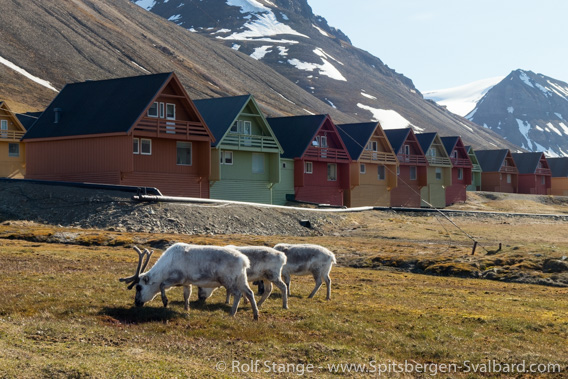
For most people, Longyearbyen is a good place where you can have a good and safe life.
But there are exceptions, and for them, life can be even more difficult than it would be in mainland Norway.
A lawyer who works with victims of domestic violence comments this as follows: “It appears as if Svalbard is Norwegian when it suits us and suddenly it is not Norwegian when it does not fit us.”
Two police cases of domestic violence since 2020
Two cases of domestic violence have been investigated by the police since early 2020. Sysselmann Kjerstin Askholt points out that the police follows these cases up just in the same way as on the mainland. She sees Norwegians who live without residence permit in a foreign country in a relationship with a local in a similar situation and explains that, for the victim, these cases may always have other consequences than for a citizen of the respective country.
Mayor Arild Olsen recognises the problem and sees the need to investigate the matter on a political level.
Hanne Stenvaag, leader of the krisesenteret (crisis centre) in Tromsø, is afraid that there may be a high number of unreported cases.
Parts of Nybyen closed because of avalanche risk
The weather in Spitsbergen has largely been rather unfriendly for a while with a lot of wind, snow and comparatively mild temperatures. The Easter weekend was not as ideal for long trips into the outdoors as many would have wanted. A group of ski expeditioners who wanted to go “Spitsbergen på langs”, a demanding tour from the south cape to the north point of the main island, had to be picked up by helicopter just days after the start.

Gruvefjellet above Nybyen (the buildings are part of Nybyen).
Currently, the weather forecast again includes a lot of wind and snow for Longyearbyen and large parts of Svalbard, and this involves a high avalanche risk. The official warning system
wieder Wind und Schnee bereit. Daher gilt in Longyearbyen und großen Teilen Svalbards wieder varsom.no is now on “red” (stage 4 out of 5).
Large cornices have built up at Gruvefellet next to Nybyen, the upper part of Longyearbyen. These cornices may break off at any time and put buildings at risk. The Sysselmannen has concluded that the only way to keep everybody safe is to evacuate parts of Nybyen until further notice. This includes the buildings on the east side of the road and the adjacing slope of Gruvefjellet. Everybody has to leave from this area until 1800 today (Friday). The evacuation can only be lifted by the Sysselmannen, and it is not known when this will happen.
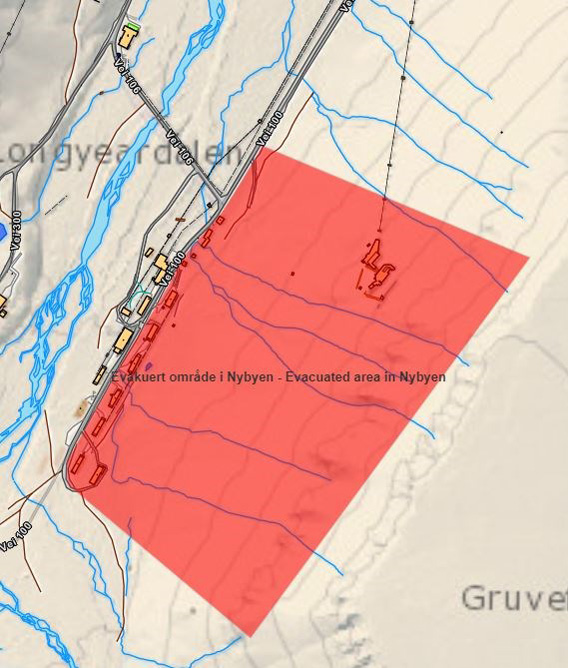
The closed area in and near Nybyen.
Map © Norsk Polarinstitutt / Sysselmannen på Svalbard.
Avalanche risk: parts of Longyearbyen evacuated
The weather forecast predicts strong southeasterly winds, reminiscent of the situation just before and during the fatal avalanche in December 2015 during which 2 people died in their homes.
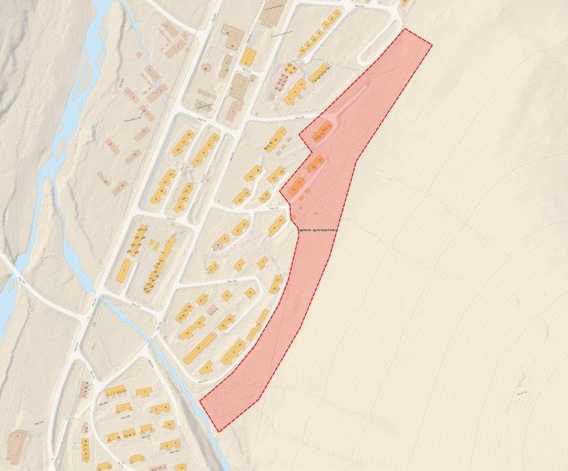
The red zone near Lia, the part of Longyearbyen next to the mountain Sukkertoppen, may not be entered until from Saturday 8 a.m. until further notice from official side. The buildings shown in the red area were destroyed by the catastrophic 2015 avalanche.
Map © Norsk Polarinstitutt / Sysselmannen på Svalbard.
The Sysselmannen has reacted and evacuated parts of Longyearbyen that may be at risk. This concerns a couple of houses in Nybyen on the east side of the road, near the slope of the mountain, and the lower slopes of Sukkertoppen next to Lia (the part of Longyearbyen that has the lovely old wooden buildings with pitched roofs). This is where houses were destroyed during the avalanche a few days before Christmas 2015.
The areas concerned must be evacuated until Saturday morning 08:00 and they may not be entered until further notice by the Sysselmannen. People can not arrange private accommodation can contact the local administration. There are fewer locals, tourists and students in Longyearbyen now than in normal times due to the corona crisis, so accommodation should generally be available.
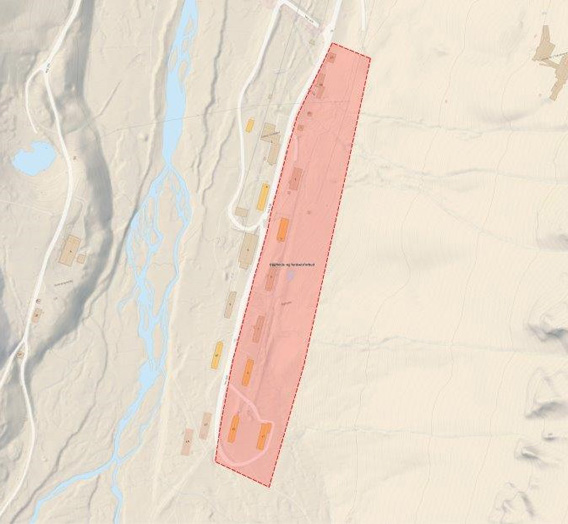
The red zone in and near Nybyen in upper Longyearbyen is off limits as of Saturday 8 a.m. and until further notice from the Sysselmannen.
Map © Norsk Polarinstitutt / Sysselmannen på Svalbard.
The Sysselmannen reminds everybody that there is a high avalanche risk in the field. The Norwegian avalanche warning website Varsom.no currently indicates risk level 3 (orange) for Nordenskiöld Land.
Svalbard soon vaccinated
The Norwegian government has announced to give Svalbard priority in the national Covid 19 vaccination programme. The main reason is that a local outbreak would quickly put the emergency services under high pressure because of the distance to the mainland of Norway. The local hospital does only provide basic medical services, and Covid-19 patients would have to be flown out to Tromsø.
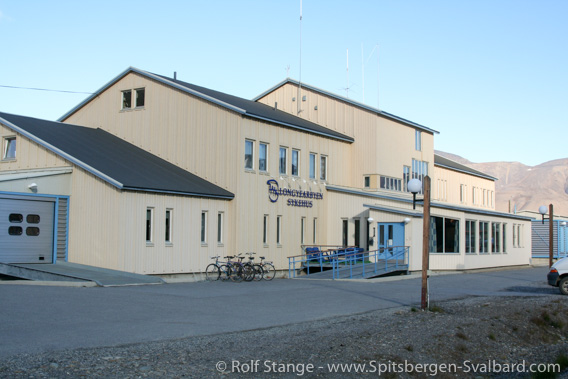
Longyearbyen hospital would not be able to handle a corona outbreak, so the remote community will soon be vaccinated.
The idea is to vaccinate everybody who is 45 or older as soon as possible. This is announced to start now in March. Until now, only elderly people have been vaccinated, according to Norway’s nationwide vaccination priority plan.
The Arctic Wednesday: second run!
For all readers who understand some German: Birgit Lutz and I will continue our successful online series of arctic presentations “The arctic Wednesday”, starting on 17 March.
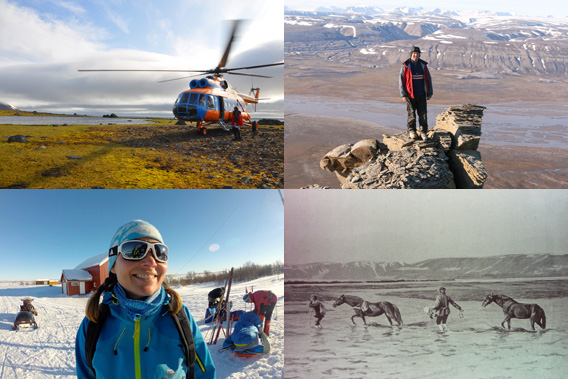
The arctic Wednesday: 6 arctic online presentations.
Please refer to the German version of this article by clicking here or on the language icon on top of this page for more details 🙂
Return of the sun celebrated in Longyearbyen
The return of the sun to Longyearbyen, solfest in Norwegian, is traditionally celebrated on 08 March, the day when the sun is directly visible from town after several months of polar night. This is the case at the staircase of the old hospital, which does not exist anymore (but a replica of the stairs is there), near the church.
Usually, the solfest comes with a whole series of cultural events over several days, the sun celebration week (solfestuke). The cultural part suffered obviously heavily from corona restrictions.

Sun festival 2021, on 8 March in Longyearbyen. Photo © Max Schweiger.
Max Schweiger is in Longyearbyen and kindly provided a couple of photos of today’s celebration.
The sun is actually visible from lower Longyearbyen, near the shore of Adventfjord, but this part of Longyearbyen, now known as Sjøskrenten, did not exist when the tradition of the sun celebration was started.
Every year, a new emblem is made the sun festival. It is chosen from drawings made in Longyearbyen’s kindergartens. This year’s selection is clearly very appropriate!
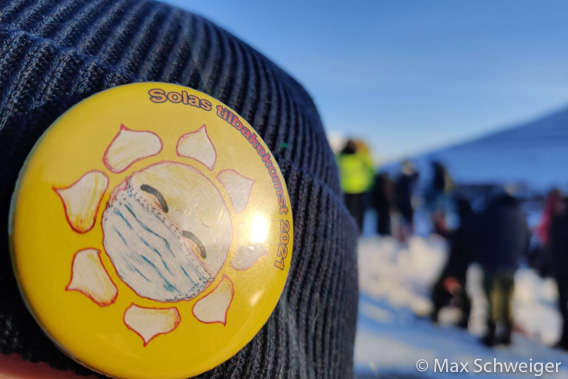
This year’s emblem for the sun festival. Photo © Max Schweiger.
With the sun celebration, the long polar night is “officially” over in Longyearbyen. The late winter with a lot of light is now there, followed by a short spring and then the summer with the midnight sun. A lot of light that follows on a long, dark period. May this very soon be the case also for the rest of the world!
Polar bear shot in Mohnbukta, man injured
A man was injured and a polar bear shot and killed earlier today in Mohnbukta on the east coast of Spitsbergen, according to the Sysselmannen.
To persons were on the fast ice in Mohnbukta with snow mobiles. Both were employees in the film production company Jason Roberts Productions and on the ice to measure the thickness. As far as currently known, the men were not aware of the presence of the bear until it attacked from behind. One man received injuries during the attack, the other one shot the bear.

Polar bear on the ice in Mohnbukta (archive image).
The Sysselmannen arrived soon on site by helicopter with police and rescue forces. The infured man was soon delivered to the hospital in Longyearbyen. His injuries are said to be minor.
Both persons appear to be experienced locals. The case is under investigation by the Sysselmannen. Polar bears are protected in Spitsbergen.
Norwegian coal mining in Spitsbergen to end in 2028
Coal is an energy carrier source of the past. This is also the case in Spitsbergen, where the power supply of most of the few remaining settlements is till based on coal. Work has been going on for more than just a while in Longyearbyen to replace today’s coal power plant with a more modern, more environmentally friendly and more reliable energy supply. The question as to which energy source will be used, or which combination of various energy sources, remains yet to be answered, several options are still debated. But the aim is to have a new energy supply up and running within 5 years.
Expecting that the new solution will not involve coal, the Norwegian mining company Store Norske Spitsbergen Kulkompani has decided to put an end to coal mining in mine 7, the last Norwegian coal mine in Spitsbergen that is still producing coal, when the coal power plant is history, according to Svalbardposten. Hence, mining is expecte to cease in mine 7 in 2028. Store Norske then expects to use 2 years for a major clean-up.
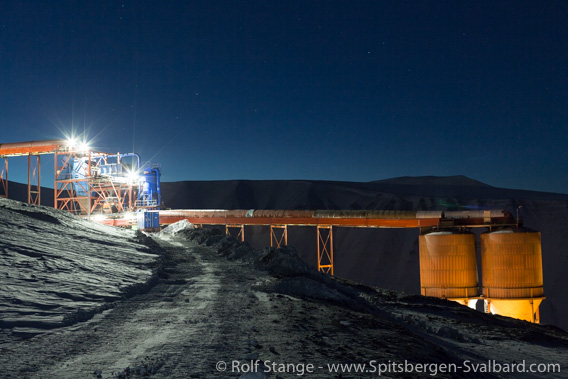
Mine 7 near Longyearbyen: end of Norwegian coal mining in Spitsbergen expected in 2028.
Store Norske expects growth and new jobs in business areas such as new solutions of energy supply, logistics, property and housing.
Sveagruva, for decades Norway’s largest coal mining settlement in Spitsbergen, is already in an advanced stage of a major clean-up process. The Russian in Barentsburg may, for some time, be the only ones who run an active coal mine in Spitsbergen, but also here – coal mining won’t last forever. The end of coal production in Barentsburg has been forecasted already more than once, with mining coming to an end in years that are now already history. But it appears fair to assume that Russian coal mining won’t continue much beyond 2030, if at all.
Local tour operators: 65 % loss, support to come soon
Local tour operators in Longyearbyen have to deal with losses of 65 % in average due to corona. For some, the last year has been a total loss, some companies and individuals would be happy to have a remaining turnover of 35 %. Others have some bookings by tourists coming from mainland Norway, but also these don’t come in numbers comparable to previous years. There is no international tourism due to the current travel restrictions. It remains to be seen when things really get better.
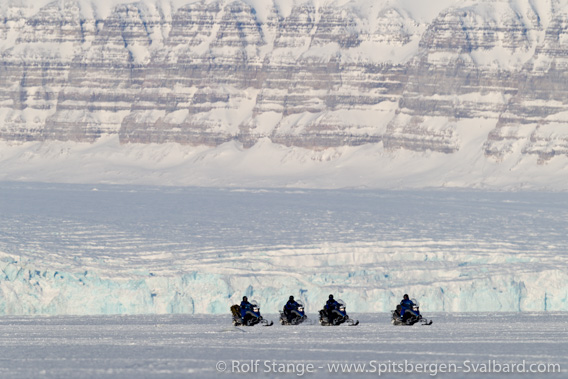
Winter tourism in Spitsbergen:
will largey be a loss this year – again.
At least, local tour operators can now expect 40 million kroner (3.9 million Euro) as public support support from Oslo. It is too early to say if all companies will survive the current crisis even considering this new financial aid. The upcoming winter season, normally peaking in March and April, will mostly not happen this year.
The “arctic Wednesday” continued: online presentation about the Mosaic expedition, 3 March
The series of 6 arctic online presentations in the series “The Arctic Wednesday” that Birgit Lutz and I have started is over – but this is not the end of the Arctic Wednesday. It has been just too good to stop it now.
The presentations will be held in German.
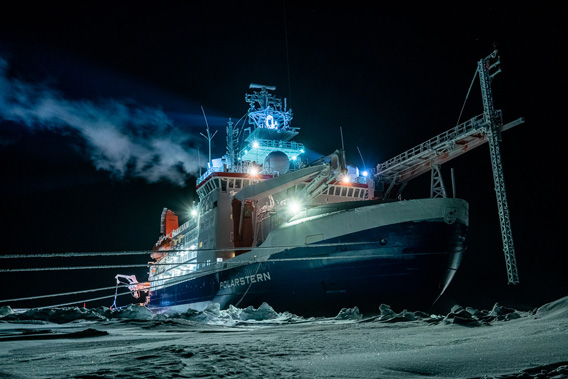
The research icebreaker Polarstern during the Mosaic expedition:
Presentation in the series “Arctic Wednesday” on 3 March.
Birgit and I are, however, not the only ones who have got some stories to tell. On 3 March, Udo Zöphel will talk about his experiences as a polar bear guard for scientists during several arctic winter months as a member of the Mosaic expedition, drifting with the icebreaker Polarstern with the ice across the Arctic Ocean. Click here for more information about the presentation (the link will open a German page, but the presentation will also be held in German).
After a little break, Birgit and I will come up with several more dates in March. We will present the new dates on 03 March. See you then! 🙂
Ski marathon cancelled
The ski marathon, one of Longyearbyen’s major annual events in the calendar of sports and culture and in 2021 scheduled for 17 April, has now been cancelled because of corona for the second time in a row. The ski marathon is organised by Svalbard Turn, a local sports club in Longyearbyen. For the club, the cancellation involves a lot of effort and a major financial loss. Longyearbyen loses a major event that used to bring several hundred international participants in recent years, making the marathon an important event also for the local tourism industry including hotels, restaurants and tour operators.
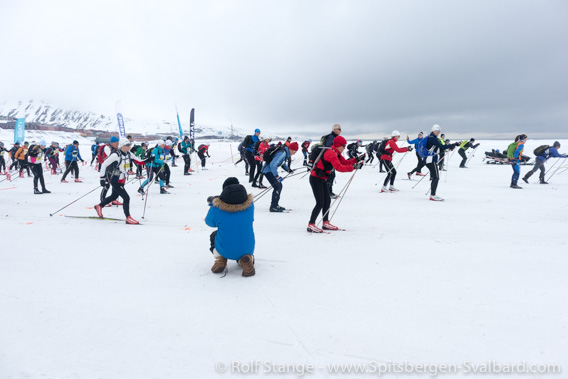
The ski marathon in Longyearbyen has now been cancelled because of corona – for the second time.
Svalbard Turn now puts their hopes on the conventional marathon on 05 June. The participants of the ski marathon can re-book for 23 April 2022. This includes a large number of people who wanted to to the marathon already in 2020.
Strict rules for cruise ships until at least end of April
The strict rules for ship-based tourism in Norway including Spitsbergen will remain in force until at least end of April, according to an official press release by the Norwegian government.
Most ship owners and tour operators had to cancel their arctic season in 2020 completely. Only a few cruises were actually carried out, for example by the Cape Race, the Origo and the Le Boreal, with strict hygiene measures. This was, in these cases, done successfully without any cases of Corona (SarsCov-2, Covid19) on board. The corona outbreak on the Hurtigruten ship Roald Amundsen, however, shows that it is difficult to achieve absolute safety.
Restrictions include a complete ban on larger ships and a reduction of the passenger capacity to 50 %, something that makes operation economically impossible for many companies. These and other restrictions (see Lovdata.no (Norwegian) for all details) remain in force during the spring, as could be expected.
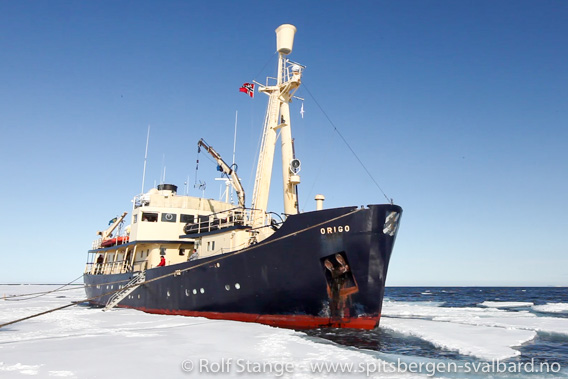
The Origo: one of a few ships that actually did some cruises in Spitsbergen in 2020.
The Norwegian government has announced to monitor the situation and to make a decision until 01 May about extending the restrictions or modifying them as appropriate.
General restrictions on international travelling as well as the new requirements for corona testing before travelling from mainland Norway to Spitsbergen remain in force.
Corona tests for Spitsbergen travellers, tourism in heavy seas
Corona test requirements: difficult in real life
Since last Friday, all travellers to Spitsbergen need to show a negative corona test that mus not be older than 24 hours. This requirement comes from the Norwegian health minister and it was communicated on Thursday afternoon, just a couple of hours before it came into force. Local authorities, including the Sysselmannen and the community administration in Longyearbyen, were not involved. It is, however, difficult to get a test prior to departure in Oslo or Tromsø. There is a test station for rapid tests at the airport in Tromsø, but will soon be closed according to Svalbardposten. This leaves travellers from Tromsø with the option for PCR tests, but it takes usually 2-3 days to get the result. Not helpful if the required maximum is 24 hours.
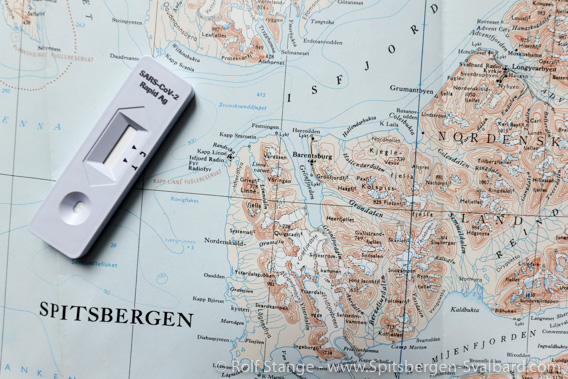
Corona-test on the way to Spitsbergen.
There is not much more official information than the hint that all travellers are themselves responsible to get a valid test in time.
Tour operators in Longyearbyen put staff on leave
There is currently hardly any international traffic to Spitsbergen. Travellers come almost exclusively from mainland Norway, both locals and tourists, in numbers that are a faint shadow of what Longyearbyen was used to until 2019. Major local tour operators have now told Svalbardposten to put employees on leave: Hurtigruten Svalbard will send about 40 out of 100 employees home, for part of their time or fully, while 20 of 70 staff of Svalbard Adventures will loose 50 % of their work soon. It is uncertain when they can return to their workplaces again fully (or at all). Normally, February would be the start of the important local winter season.
Public money does not reach the companies as needed
John Einar Lockert, head of Svalbard Adventures in Longyearbyen, feels himself made a fool by governmental financial aids and regulations. Companies who decided to keep their operation up and running lose rights to funding. Instead, there are fundings for restructuring measures, something many companies do currently not have any economical power for. Spontaneous regulatory initiatives such as the requirement for corona tests for travellers which was introduced after only a few hours of warning time are not experienced as helpful.
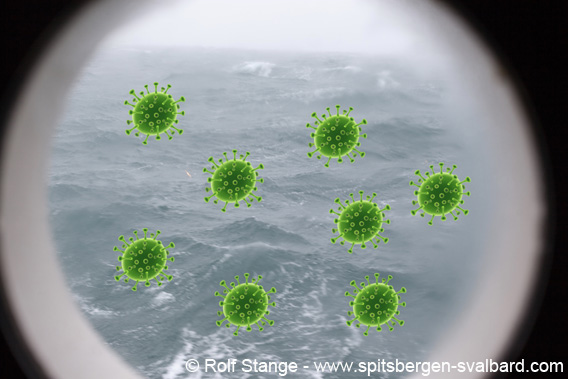
Tourism is, due to corona, currently in heavy seas.
Self-employed people often out in the rain
Not only artists, but also one-man-companies within tourism are often just left without public support, in Longyearbyen, Germany and other countries. Self-employed guides, for example, who usually offer their services to companies on a contract-basis, try to engage themselves in creative solutions wherever possible, and as soon as this is not available anymore, they use up their reserves and then depend on partners, families and friends.
News-Listing live generated at 2025/May/09 at 23:36:33 Uhr (GMT+1)












